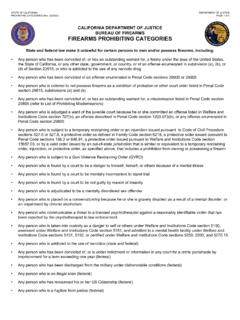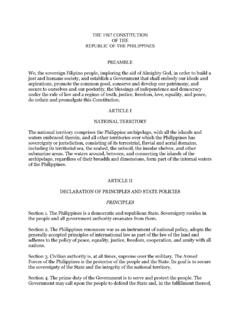Transcription of The Bichard Inquiry - Report - UCL Institute of Education
1 The Bichard Inquiry Report A Public Inquiry Report on child protection procedures in Humberside Police and Cambridgeshire Constabulary, particularly the effectiveness of relevant intelligence-based record keeping, vetting practices since 1995. and information sharing with other agencies. This Report makes recommendations on matters of local and national relevance. The Bichard Inquiry Report HC653. Return to an Address of the Honourable the House of Commons dated 22nd June 2004. for The Bichard Inquiry Report Ordered by the House of Commons to be printed 22nd June 2004. HC653 London: The Stationery Office Parliamentary copyright 2004. The text of this Report may be reproduced in whole or in part free of charge in any format or media without requiring specific permission.
2 This is subject to the material not being used in a derogatory manner or in a misleading context. Where the material is being republished or copied to others, the source of the material must be identified and the copyright status acknowledged. The full text of this document has been published on the Internet and can be accessed at: Any enquiries relating to the copyright in this Report should be addressed to Her Majesty's Stationery Office, Licensing Division, St Clements House, 2-16 Colegate, Norwich, NR3 1BQ. Fax: 01603 723000 or email: Contents Introduction and summary by Sir Michael Bichard 1. Recommendations for action 13. The Inquiry process 19. 1 CONTACTS, RECRUITMENT AND VETTING THE FACTS. An overview 23. Dealing with the contacts as they happened 24.
3 How Humberside Police and/or Social Services handled the 11 contacts with Huntley 24. Contact A 26. Record keeping: Contact A 26. Contact 1 (allegation: unlawful sexual intercourse) 26. Record keeping: Contact 1 30. Contact 2 (allegation: burglary) 31. Record keeping: Contact 2 32. Contact 2A (allegation: unlawful sexual intercourse) 33. Record keeping: Contact 2A 35. Contact 3 (allegation: unlawful sexual intercourse) 35. Record keeping: Contact 3 39. Contact 4 (allegation: unlawful sexual intercourse) 39. Record keeping: Contact 4 41. Contact 5 (non-appearance for the burglary summons/. non-payment of fine) 41. Record keeping: Contact 5 41. Contact 6 (allegation: rape) 42. Record keeping: Contact 6 42. Contact 7 (allegation: rape) 43. Record keeping: Contact 7 45.
4 Contact 8 (allegation: indecent assault on a child aged 11) 47. Record keeping: Contact 8 48. Contact 9 (allegation: rape) 49. Record keeping: Contact 9 50. Contact 10 (allegation: rape) 51. Record keeping: Contact 10 53. Huntley's application for disclosure under the Data Protection Act 1998 53. The Bichard Inquiry Contents i The recruitment and vetting processes 54. Recruitment 55. Soham Village College 55. EPM 57. The police vetting process 60. Cambridgeshire Constabulary 60. Humberside Police 67. The Huntley vetting check December 2001 68. 2 CONTACTS, RECRUITMENT AND VETTING THE FINDINGS. Events in Humberside 77. Humberside Police 77. Failure to maintain adequate intelligence 77. Failure to identify a pattern 88. Humberside Police's senior management 94.
5 Conclusions about Humberside Police 98. Her Majesty's Inspectorate of Constabulary 100. Humberside Police Authority 101. Social Services 101. Events in Cambridgeshire 103. Cambridgeshire Constabulary 103. Soham Village College 107. Education Personnel Management Ltd 108. 3 NATIONAL SYSTEMS AND STRUCTURE THE FACTS. The legislation 109. The Data Protection Act 1984 109. The Data Protection Act 1998 110. The Human Rights Act 1998 111. The policing structure 111. The structure up to October 2002 111. After October 2002 the Police Reform Act 2002 112. Review, inspection and the strategic bodies 113. Information systems 115. The Police National Computer (PNC) 115. National Strategy for Police Information Systems (NSPIS) 117. Local IT systems, applications and criminal intelligence 118.
6 Information management 119. The National Intelligence Model 119. Reviewing, retaining and deleting records 119. Recruitment and the national vetting system 122. Recruitment 122. Overview of the basic vetting regime 122. ii The Bichard Inquiry Contents 4 NATIONAL SYSTEMS AND STRUCTURE THE FINDINGS. The legislation 127. Data protection 127. The relationship between ACPO and the Information Commissioner 128. The policing structure 128. Information systems 129. Little progress with a national intelligence IT system 129. PITO 130. ACPO and the Home Office 130. The Scottish intelligence-gathering model 131. An interim solution the PLX 132. Finding the best IT procurement 132. The future of the PNC 133. Information management 134. National guidance on record creation, retention and deletion 134.
7 Handling allegations of sexual offences against children 138. Recruitment and vetting 140. Recruitment and selection 140. Vetting 141. The current framework issues and improvements 142. A new system licence or registration 150. Taking things forward 155. Glossary 157. Appendix 1: Areas of interest to the Inquiry 163. Appendix 2: Evidence received by the Inquiry 165. Appendix 3: Humberside Police records and Social Services records 171. Appendix 4: Vetting, the List schemes and Enhanced Disclosure 179. Appendix 5: The Inquiry team 187. Index 189. The Bichard Inquiry Contents iii Introduction and summary by Sir Michael Bichard 1 On 17 December 2003, Ian Huntley was convicted of the murders of Jessica Chapman and Holly Wells. It is difficult to exaggerate the horror which these murders caused or to begin to imagine the grief of the girls' families.
8 2 In the days following Huntley's conviction , there was widespread public disquiet when it became clear that he had been known to the authorities over a period of years. In fact, he had come to the attention of Humberside Police in relation to allegations of eight separate sexual offences from 1995. to 1999 (and had been investigated in yet another). This information had not emerged during the vetting check, carried out by Cambridgeshire Constabulary at the time of Huntley's appointment to Soham Village College late in 2001. 3 This Inquiry was set up by the Home Secretary to: Urgently enquire into child protection procedures in Humberside Police and Cambridgeshire Constabulary in the light of the recent trial and conviction of Ian Huntley for the murder of Jessica Chapman and Holly Wells.
9 In particular to assess the effectiveness of the relevant intelligence-based record keeping, the vetting practices in those forces since 1995 and information sharing with other agencies, and to Report to the Home Secretary on matters of local and national relevance and make recommendations as appropriate.'. 4 As I made clear in my opening statement in January 2004, my aim has been to discover what happened, why it happened and what lessons could be learned and conclusions drawn. That has inevitably involved asking some tough questions and criticising individuals and organisations. 5 Huntley alone was responsible for, and stands convicted of, these most awful murders. None of the actions or failures of any of the witnesses who gave evidence to the Inquiry , or the institutions they represented, led to the deaths of the girls.
10 6 However, the Inquiry did find errors, omissions, failures and shortcomings which are deeply shocking. Taken together, these were so extensive that one cannot be confident that it was Huntley alone who slipped through the net'. The Bichard Inquiry Introduction and summary 1. 7 The detailed facts and findings are set out in the body of the Report . In this summary, I highlight the main conclusions. In Humberside and North East Lincolnshire Humberside Police 8 One of the key failings was the inability of Humberside Police and Social Services to identify Huntley's behaviour pattern remotely soon enough. That was because both viewed each case in isolation and because Social Services failed to share information effectively with the police. It was also because, as the Humberside Chief Constable admitted in his evidence, there were systemic and corporate' failures in the way in which Humberside Police managed their intelligence systems.



















